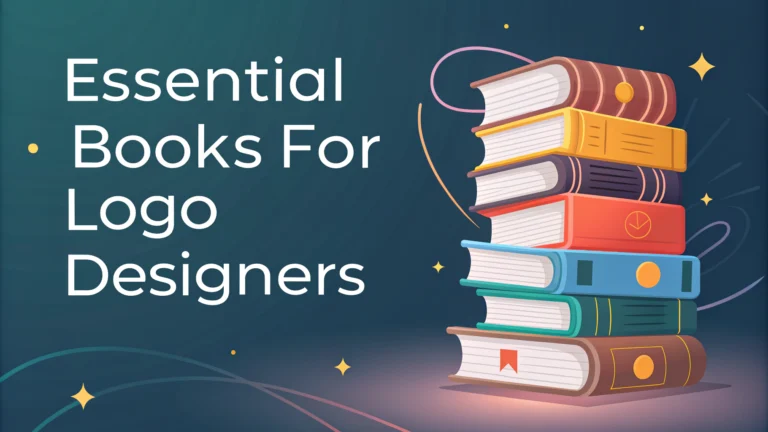Books remain invaluable resources for logo designers looking to master their craft and stay current with design principles.
This quick guide highlights select books that offer practical insights for both new and experienced logo designers.
Must-Read Logo Design Books
- Logo Design Love by David Airey – Practical guide covering real client projects and business aspects of logo design
- Designing Brand Identity by Alina Wheeler – Comprehensive toolkit for brand identity design
- Symbol by Angus Hyland – Collection of over 1300 symbols with detailed analysis
- Logo Modernism by Jens Müller – Extensive examination of modernist logos from 1940-1980
Books for Design Fundamentals
- Grid Systems in Graphic Design by Josef Müller-Brockmann – Essential guide to using grids
- Color Design Workbook by Terry Lee Stone – Color theory and application guide
- Typography Workbook by Timothy Samara – Comprehensive typography resource
Business-Focused Design Books
- Work for Money, Design for Love by David Airey – Business advice for designers
- The Win Without Pitching Manifesto by Blair Enns – Client relationship and business development guide
Online Resources to Complement Your Reading
- LogoDesignLove.com – David Airey’s blog with regular updates and case studies
- BrandNew.com – Reviews and analysis of brand identity projects
- AIGA.org – Professional association for design with educational resources
Each book mentioned can be purchased through major retailers like Amazon, Barnes & Noble, or directly from publishers.
Reading Strategy Tips
- Start with one fundamental book and one business-focused book
- Take notes and create a digital reference system
- Apply concepts immediately to real or practice projects
- Join online design communities to discuss book insights
Regular reading combined with practical application helps build a strong foundation in logo design.
| Experience Level | Recommended First Book |
|---|---|
| Beginner | Logo Design Love |
| Intermediate | Designing Brand Identity |
| Advanced | Logo Modernism |
Additional Learning Resources
- Design Workshops – Local and online workshops provide hands-on experience
- Video Tutorials – Platforms like Skillshare and LinkedIn Learning offer structured courses
- Design Podcasts – “Logo Geek” and “The Futur” provide industry insights
Building Your Design Library
Developing a personal design library requires strategic investment. Focus on building a diverse collection that covers:
- Technical skills and fundamentals
- Business practices and client management
- Historical perspectives and case studies
- Contemporary trends and innovations
Maintaining Current Knowledge
- Subscribe to design magazines and journals
- Follow respected designers on social media
- Attend design conferences and webinars
- Participate in design challenges and competitions
Conclusion
Success in logo design requires continuous learning through both theoretical knowledge and practical application. The recommended books provide a solid foundation, while online resources and community engagement offer ongoing development opportunities. Regular study, combined with active practice, helps designers stay competitive and deliver exceptional work to clients.
| Learning Method | Time Investment |
|---|---|
| Book Study | 3-5 hours/week |
| Online Resources | 2-3 hours/week |
| Practical Application | 5-10 hours/week |
FAQs
- What are the most essential books every logo designer should read?
Logo Modernism by Jens Müller, Logo: The Reference Guide to Symbols and Logotypes by Michael Evamy, and Logo Design Love by David Airey are considered fundamental reading materials for logo designers. - How important is color theory knowledge for logo design?
Color theory is crucial for logo design as it affects brand recognition, emotion, and versatility. Understanding color psychology and color combinations helps create logos that work across different mediums and convey the right message. - What software is industry-standard for logo design?
Adobe Illustrator is the industry-standard vector graphics software for logo design. Other useful programs include Affinity Designer and CorelDRAW for vector-based logo creation. - Should logos always be designed in vector format?
Yes, logos should always be created in vector format to ensure scalability without quality loss, enabling usage from small business cards to large billboards. - How many concepts should be presented to a client?
Professional logo designers typically present 3-5 strong, distinct concepts to clients, each demonstrating different approaches to the design brief. - What makes a logo timeless?
Timeless logos feature simple, memorable designs, avoid trendy elements, use classic typography, and focus on strong concept rather than elaborate decoration. - How important is negative space in logo design?
Negative space is crucial in logo design as it can create clever visual elements, improve readability, and make logos more memorable, as seen in famous examples like FedEx and World Wildlife Fund. - What file formats should be delivered to clients?
Designers should provide AI or EPS (vector source files), PDF, SVG, and various PNG and JPG sizes, including both RGB and CMYK color versions. - How does typography impact logo design?
Typography plays a vital role in logo design by conveying brand personality, ensuring readability, and creating visual hierarchy. Custom letterforms often make logos more unique and memorable. - What is the golden ratio and why is it important in logo design?
The golden ratio (1:1.618) is a mathematical principle that creates aesthetically pleasing proportions in logo design, often used to achieve balanced and harmonious compositions.








